It’s been 12 years since the last Year of the Rabbit when Sorelle Saidman and the Rabbitats rescue program began their quest to solve the Lower Mainland’s feral rabbit problem. Rabbits are routinely dumped by their human owners into the wild. They can give birth to feral offspring every month, which burrow and feast in public parks and suburban landscaping. And they’re too cute for passersby to resist regularly feeding them, despite it being illegal, and many wouldn’t want them gone.
“Our big deal was to solve the rabbit issue by the next Year of the Rabbit,” said Saidman, who in 2011 founded Rabbitats, a charitable organization that specializes in rescuing and housing feral and abandoned rabbits.
“That didn’t quite happen.”
The Year of the Rabbit on the lunar calendar has come again this year, widely celebrated by many of Vancouver’s East and Southeast Asian diaspora.
Despite the missed mark, Rabbitats has been hard at work these past 12 years trying to rehome and manage the prolific population. B.C. cities like Victoria and Kelowna have experienced their own bunny booms in that time, but the epicentre the organization is mainly focused on is Richmond.
The city has a large East Asian population and half of Rabbitats’ volunteers are of East Asian descent. They’ve encountered racist comments from passersby when rescuing feral rabbits, such as asking whether they’re planning to eat them. Some have expressed concern to the organization about adopting out rabbits to East Asian owners. One of Rabbitats’ goals this rabbit year is to address that racism.
Richmond is home to some 1,000 to 2,000 rabbits, Saidman estimates. The Richmond Auto Mall in particular, Western Canada’s largest, was overrun with as many as 400 rabbits for about a decade before Rabbitats was invited in to help. They are the largest rabbit-centered organization in the area that does this kind of work.
Their operation proved that Rabbitats’ ethos works, says Saidman: “Trap, neuter and contain.”
As for where to put them, the rabbits — being in the pricey Lower Mainland where properties are routinely sold — are in a housing crisis of their own.
Housing rapidly reproducing rabbits
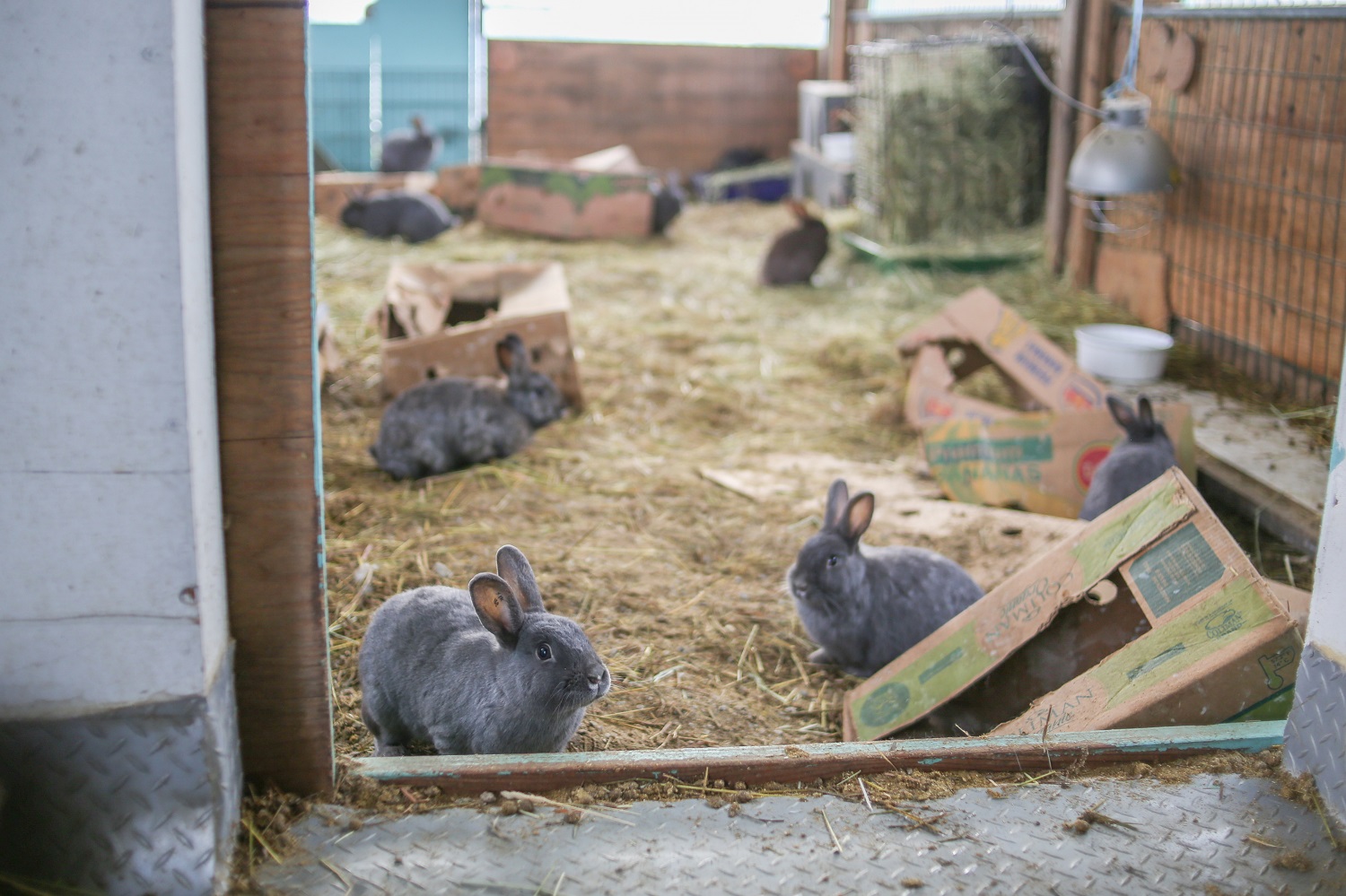
On one of Richmond’s many blueberry farms, Rabbitats has built something of a rabbit village for over 350 rabbits rescued from the region.
Each enclosure — roofed and with underground wire to prevent escapes by burrowing — is home to its own colony of rabbits close in age, from patterned harlequins to large white rabbits with pink eyes.
“They don’t always get along,” said volunteer Judy Quinn. “So when you put a colony together, you have to watch it quite carefully so they don’t get into trouble.”
Their furniture includes benches for hiding, heat lamps for warming, hay feeders for dining and cardboard boxes for playing and nibbling. The young rabbits, called kits, live in the nursery. All the rabbit droppings, marble-shaped and the product of a majority hay diet, make for good compost on the blueberry farm.
Rabbit abandonment is such a problem that Rabbitats does not publicize the shelter’s address to prevent more owners from dumping their pets they no longer want.
The feral rabbits they catch aren’t adoptable, which is why Rabbitats has so many, but their offspring are.
Unfortunately, the properties that lease to Rabbitats in Richmond and in Surrey, where there are another 150 rabbits, are up for development, says Saidman. And so is the shelter for unwanted farm animals that’s taken in 40 of their rabbits.
“When you’ve got animals — especially horses and cows and goats — you need stability. And we’ve got 500 rabbits.”
Rabbitats is looking to get out of the rental market, fundraising to buy into a unique model: a co-op in Langley with other like-minded animal organizations.
It would give them a base to care for a population that’s still on the rise, complicated by a dizzying amount of municipal and provincial bureaucracy that hasn’t tackled the problem head on, says Saidman.
On top of this, there’s the issue of rapid reproduction. A feral rabbit is capable of having a new litter of three to eight every 31 days. Owners may also misidentify a rabbit’s sex, accidentally leaving a male and a female together rather than what they believe is two of a kind, resulting in what they call “oops litters.”
While policymakers and politicians are taking up time to think of solutions, the problem is multiplying.
“Pretty much every female we rescue could be pregnant,” said Deanna Hamm, who other volunteers have dubbed the “bunny whisperer” for her skill at trapping them. One crucial piece of information is to avoid trapping them in the spring. Rabbits love sweet spring grass and cannot be enticed by other food.
Rabbitats recently got a call about an abandoned white rabbit loose in someone’s yard in Burnaby. But when they arrived, there turned out to be two.
“So we grab the white rabbits and one of them is lactating,” said Saidman. “Oh my God, so we have to find the nest. We start digging around the bushes and pull out the nest where there’s something like seven babies in the nest. So the call for the one white bunny we had room for turns into nine. And then 30 days later, she gives birth to another eight. So our call for the one white bunny turned into 17.”
Cuteness works both for and against the rabbits. Unlike, say, feral rats, which are widely despised, rabbits are adorable creatures whose popular appeal makes it difficult to deal with population control. No elected official would want to suggest a cull of these rabbits and be dubbed the “bunny killer,” said Saidman.
Saidman says a third of people that Rabbitats encounters would rather they do nothing, saying, “We really like having these bunnies around! Don’t catch them! Don’t take our neighbourhood bunnies away!”
Cull of the wild?
In the late 1990s, the Victoria General Hospital was home to as many as 700 rabbits. The population consisted of abandoned pets and their proliferating progeny. Rabbit feces and rabbit nests in vents eventually proved too much for the hospital, whose staff eventually hired a controversial killer dubbed the “hare hitman.”
Working at night, the hitman shot rabbits dead with a high-powered pellet gun. Meanwhile by day, a woman known as the Rabbit Lady stepped in to conduct her own rescue mission, trapping the hospital rabbits to be adopted out or relocated to her farm.
Not far away, the University of Victoria campus had a growing population of over 1,500 rabbits at its peak. But their ultimate destiny in 2011 featured a hoppier ending.
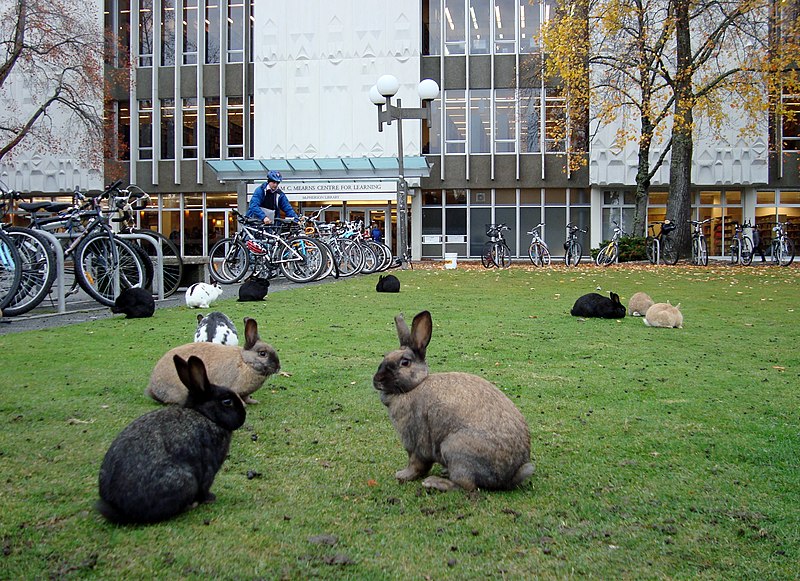
At first, the school began a cull, killing 100 rabbits, but protesters managed to successfully petition the court for an injunction. The rabbit rescuers raised enough money to fix and find new homes for the surviving 903 bunnies, some of which were airlifted to a sanctuary as far as Texas. Saidman, who was part of the university rescue effort, formed Rabbitats with others volunteers passionate about solving the feral rabbit problem.
Entire cities like Kelowna and Delta have also launched similar efforts to trap-neuter-contain their feral populations.
The Richmond Auto Mall — with its 400 or so feral rabbits hopping around the landscaping at its dealerships and eating grass, shrubs, hedges and flower beds — decided that the best course of action would be to bring in Rabbitats to do the same. The auto mall gave them a van, money to fix the rabbits and a garage to house them. In time for Easter 2017, the auto mall was free of rabbits for the first time in a decade.
Despite rabbits’ rapid reproduction, efforts like this give Saidman hope that any place overrun with buns can be turned around.
“It can be done,” she said.
‘World’s Worst Invasive Alien Species’
The rabbits most commonly seen grazing in Vancouver’s Jericho Beach Park and Richmond’s Minoru Park might look like they’re supposed to be there by unsuspecting visitors. However, the majority of these rabbits multiplying in human communities are actually two invasive species.
The most common is the European rabbit, on the list of 100 of the “World’s Worst Invasive Alien Species,” by the International Union for Conservation of Nature. The species, which comes in many colours but typically has a beige ring around its eyes, is native to Europe and North Africa but was brought to B.C. by settlers. These rabbits were both pets and farmed for their meat and fur.
There’s also the Eastern cottontail rabbit, brown with a white fluffy tail that gives it its name. Native to eastern and central North America, they were introduced to western Washington during the interwar years. From there, they spread to B.C.’s Fraser Valley. Then in 1964, they were also introduced to Sooke, B.C., from which they began spreading across eastern Vancouver Island and have been damaging Garry Oak ecosystems by overgrazing.
As for the current feral rabbit problem in B.C., Rabbitats believes it started after 1988, when the House Rabbit Society was founded in California. The organization, now worldwide, heavily promoted rabbits as house pets. With that also came abandonment and multiplying feral rabbits.
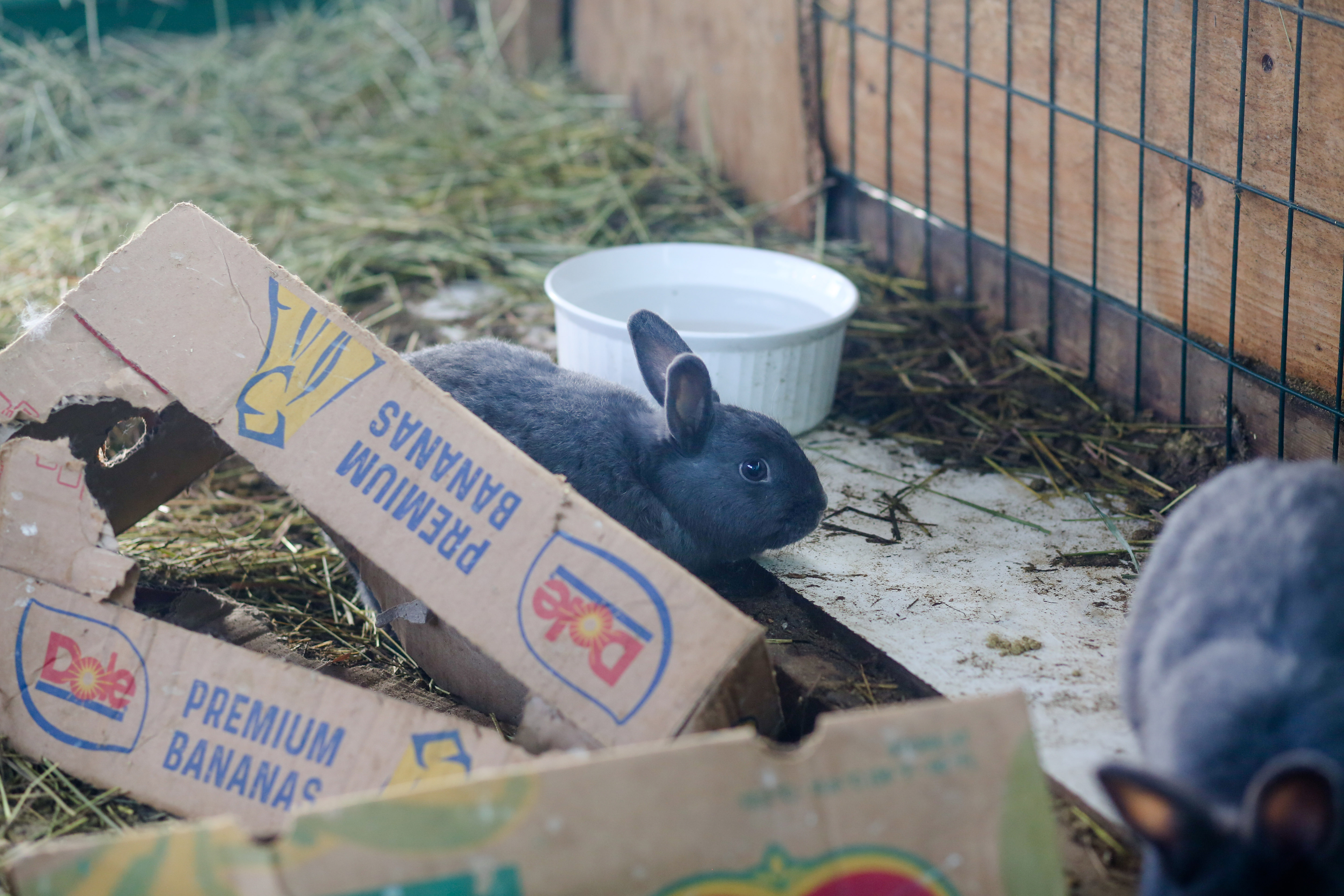
There’s usually an uptick in abandoned rabbits just after Easter, when the novelty of owning one for the holiday wears off. More recently, there’s been a significant increase as pandemic restrictions were loosened, likely pets that were adopted during COVID.
“People are going back to work [and] don’t have time for their rabbit,” said Saidman, adding that the many specialty breeds like lops and lionheads that they’ve encountered during the pandemic are an obvious sign of domestic rabbits being abandoned.
Katherine, a Rabbitats volunteer, encountered a pregnant rabbit during the pandemic in a place she didn’t know rabbits liked to hide.
“She climbed into the undercarriage of our Miata during COVID when we weren’t driving so much,” she said. “And then when my partner went to take the car, he backed out of the parking stall and baby bunnies started falling out of the engine!
“We found homes for all of them.”
Every-bun, everywhere, all at once
Public policy, from city bylaws to provincial legislation, have long had rabbit holes.
The unusual legality around rabbits is that the province considers them “wildlife” once they are released by humans, despite them being an invasive species. This limits how feral populations can be managed.
“You could watch someone take a fluffy bunny, put the bunny on the ground and walk away. And if you went to pick that bunny up, you’d need a permit,” she said.
B.C. tweaked the Wildlife Act last year to remove permit requirements for groups looking to remove them, a move Saidman says came far too late.
As for Richmond, the city banned the sale of rabbits in pet stores. But that didn’t address the rabbits sold by breeders and on online marketplaces like Craigslist and Kijiji.
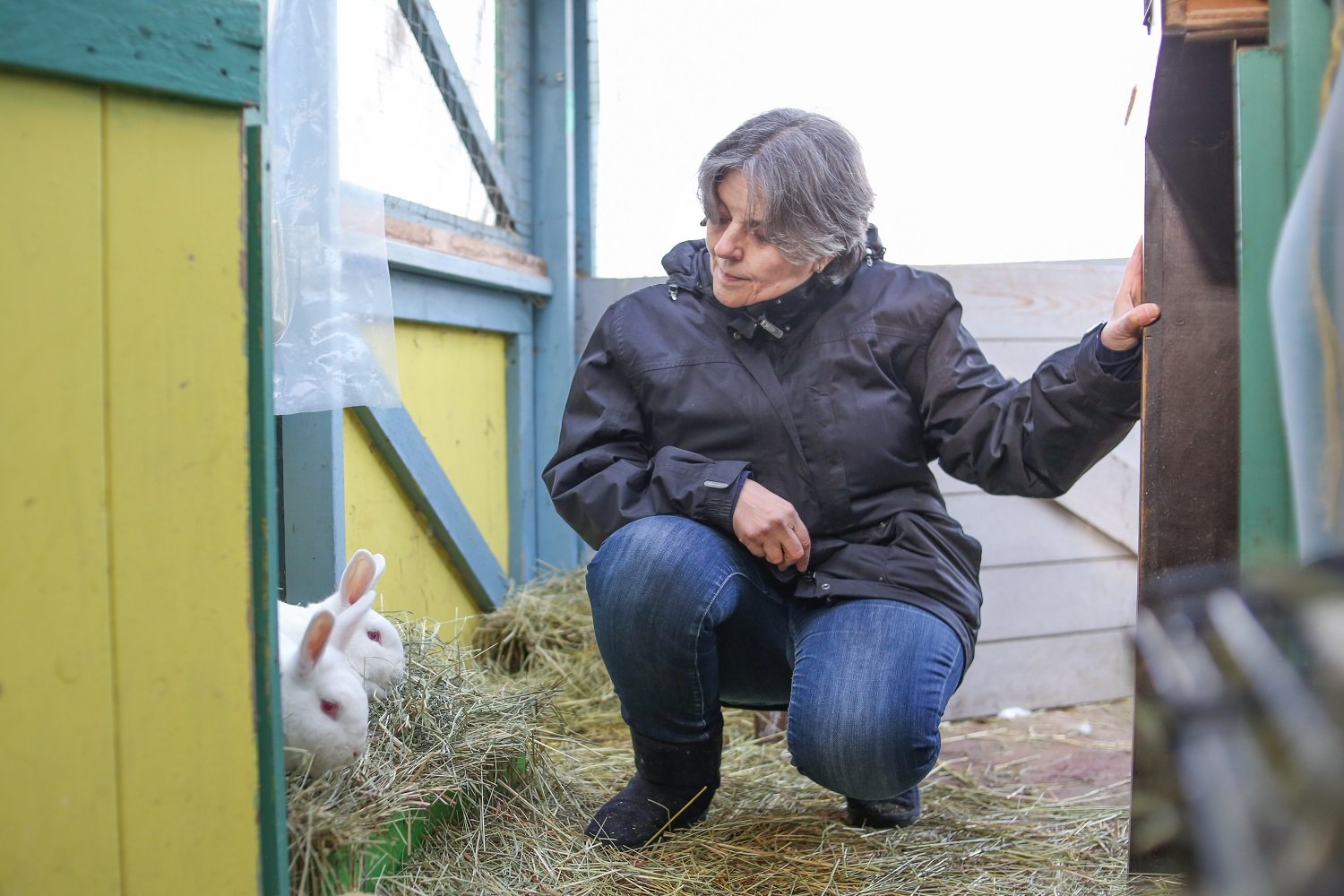
If Saidman could change rabbit policy overnight, her top suggestion would be for governments to follow a bylaw that Kelowna has already adopted: “No person shall sell or give away rabbits that have not been spayed or neutered.”
According to Richmond spokesperson Clay Adams, a survey of the city’s feral rabbit population has just been completed, along with recommendations for next steps. Adams told The Tyee in a statement that the findings will be presented to city council in the coming months.
Saidman’s hope is that the city’s recommendations will focus on population control and ask the Union of BC Municipalities to help create a co-ordinated response in communities provincewide.
Back in 2020, Rabbitats was contracted by the city on a pilot project to remove all the rabbits from Richmond’s Dover neighbourhood. Sixty-one rabbits were trapped, neutered and contained. All of the female rabbits except one were pregnant, resulting in 28 more rabbits being born.
The following year, they received a contract to do the same, but only to capture rabbits on public property that people called the city about. It frustrated Saidman because “cherry picking” doesn’t work; controlling the population is an all-or-nothing approach.
But this has since been discontinued, with Rabbitats hoping for a return to a concerted effort like at the auto mall and in the Dover neighbourhood.
“We lost an entire year,” said Saidman. “And now other areas are seeing rabbit issues which will only get worse with the post-COVID escalation in abandonment.”
The city has acknowledged the growing rabbit population and their expansion into ecologically sensitive areas like Terra Nova Rural Park and even newly created parks like Aberdeen Park and Paulik Neighbourhood Park.
“You have to pick the neighbourhood like we did with Dover and then we have to get every rabbit out of there,” said Saidman. “Then you can easily see if there’s rabbits coming into the area and you can easily pick them up and keep control of them that way. But if you're just picking up a few here and there, or even if you pick up half of a colony, the other half of the colony will go into overdrive and breed that much faster.
“Otherwise we’d just be chasing our tails as well as the rabbits.” ![]()
Read more: Rights + Justice, Environment



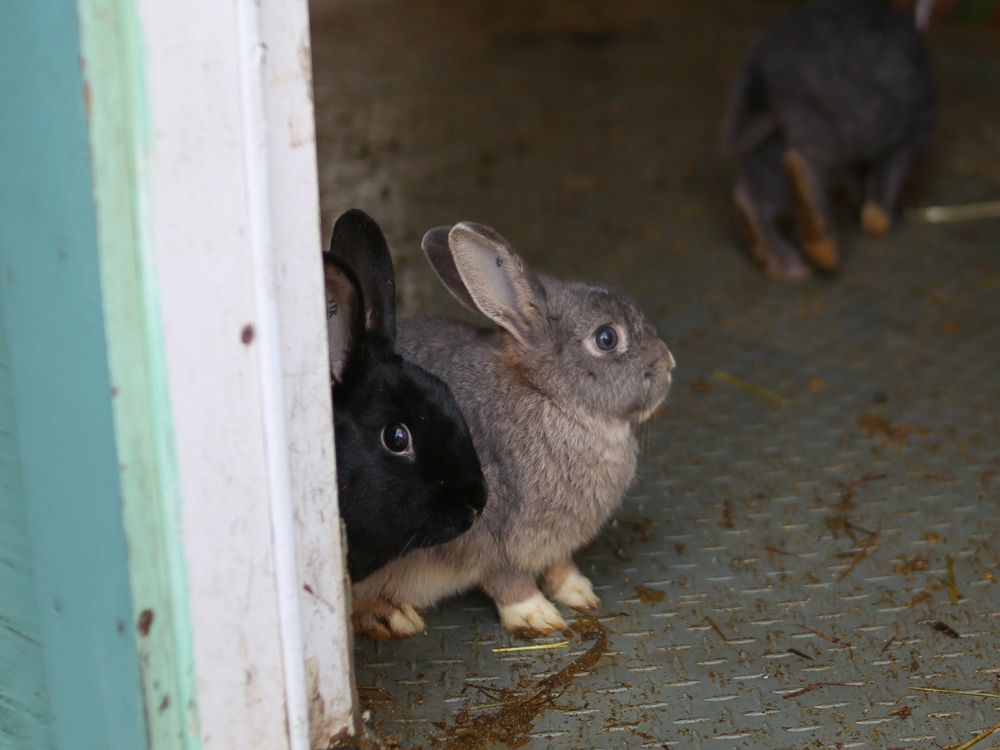












Tyee Commenting Guidelines
Comments that violate guidelines risk being deleted, and violations may result in a temporary or permanent user ban. Maintain the spirit of good conversation to stay in the discussion.
*Please note The Tyee is not a forum for spreading misinformation about COVID-19, denying its existence or minimizing its risk to public health.
Do:
Do not: